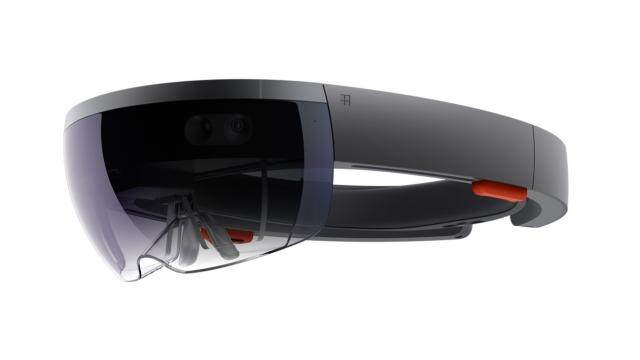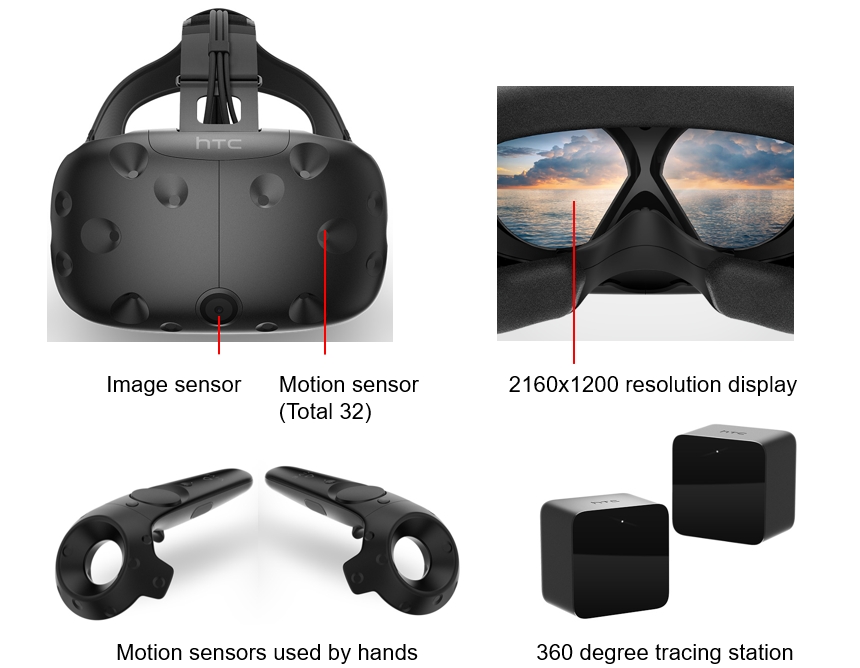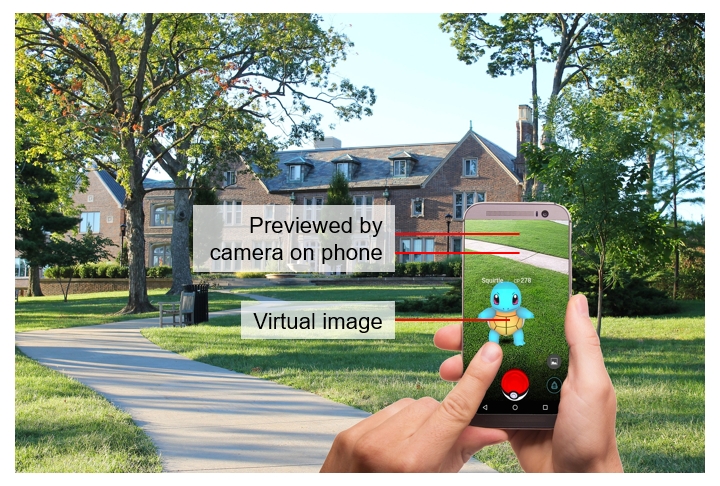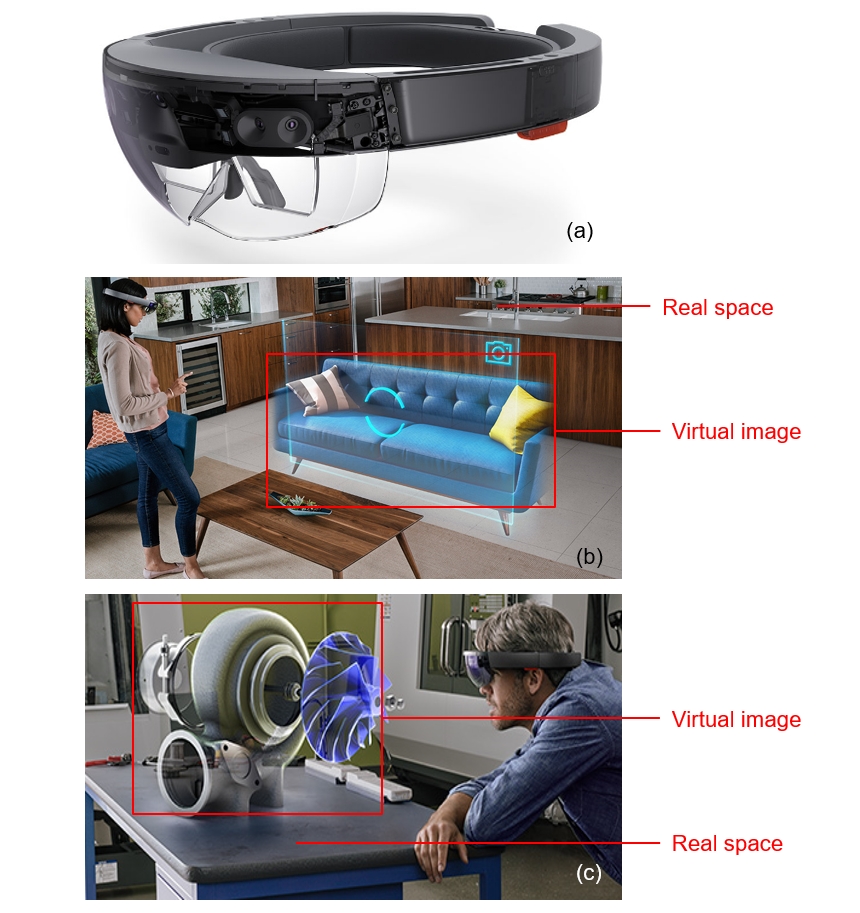文章內容
Introduction of VR/AR/MR Technology


❐ Virtual Reality (VR)
Virtual Reality (VR) employs the display technology to establish a three-dimensional and emulated virtual world that the user may feel he is in an environment as reality. Currently, most VR technologies are to design a pair of special eyeglasses to completely enclose the space around both eyes, as the Vive head wearing display shown in Fig. 1, and cooperate with suitable sound effect to generate the hearing experience. When the user is playing game, the computer must know the body movements of the user to correspondingly generate the suitable images and accomplish the interactive situation with the user. VR often further combines with a motion sensor to detect the motion of user.

Figure 1: Vive head wearing display and motion sensor.
Source: www.vive.com.
The images generated in the head wearing display of VR are usually created by animation to create a virtual world that any creator might imagine. By the fact that the left and right eyes have six centimeters difference, the user’s brain will generate the three-dimensional sense due to parallax to form the 3D image. The principle is the same as 3D motion picture we may watch in a movie theater. Let’s imagine we are playing a game for rafting. Our eyes may watch ourselves on a small boat traveling up and down in a turbulent river and we can hear the raging stream sound. Our hands can hold the motion sensor sliding back and forth, just like rowing a boat on the river. The images our eyes could see will be different as our hands slide back and forth. We may feel like we are personally on the scene!
❐ Augmented Reality (AR)
Augmented Reality (AR) is to make the virtual image augmented to a real space. AR is different from VR which established a completely virtual space around user’s eyes to replace the real space. AR is not to replace the real space, but to add virtual objects in the real space, so the user may see a world mixed with virtuality and reality. The most well-known AR game now is the Pokemon GO. When we turned on the preview function of camera on the cell phone, we could see the image of the real world in front of us on the monitor. Then, a cute pocket monster appeared on the monitor overlapped with the real world image. It may look like a pocket monster really appearing in front of us, as shown in Fig. 2, but the real world in front of our eyes is seen through the cell phone monitor.

Figure 2: Gaming picture of Pokemon Go.
AR has another important application for automotive industry. The real image in front of our eyes when we are driving is seen through the front windshield. During nighttime driving, if there were pedestrian or small animal suddenly showing up, we might not make the appropriate response in time. However, we might have a Charge Coupled Device (CCD) with high sensitivity to capture the image in front and use a processor to calculate the “virtual image” of pedestrian or small animal from the dim background; then, using a Digital Light Processing (DLP) projection technology to project the image onto the front windshield to be overlapped with the “real image” we saw, as shown in Fig. 3. The windshield might need a specially designed semi-reflective film for the image overlapping. Visually, it seems like really a pedestrian or small animal is appearing in front of our eyes, as shown in Fig. 3. We all know that it is a very dangerous action when we look down to watch the dashboard or display, but with this kind of VR technology, the driver needs not to look down to watch the screen, but look ahead through the front windshield as usual during driving to ensure the driving safety.
.jpg)
Figure 3: DLP projects image onto front windshield to form Augmented Reality.
Source: www.ti.com.
❐ Mixed Reality (MR)
VR can enable the user seeing a completely virtual image and AR can augment the virtual image into a real space. Mixed Reality (MR) is a technology combining virtual and augmented reality, which may also generate the virtual image to be augmented into a real space. The difference is that MR enables the virtual image in the real space to have more interaction with the user. For example, the user may use a gesture to place a virtual sofa image into a real living room, so the user may feel what if the sofa is really placed in the living room. If the user felt the sofa is not good, he could use a gesture to select other virtual sofa to be placed in the real living room. The gesture recognition requires a special image sensor or motion detector, and to generate a virtual image to be augmented into a real space also requires a special projection technology. Basically, the equipment required by MR should be the most complicated.
In 2015, Microsoft announced HoloLens, which is an application of MR. Fig. 4(a) shows the eyeglasses of HoloLens. This technology can display the virtual image on the eyeglasses. When the user sees the real world through the eyeglasses, he may feel a virtual object overlapped thereon. For example, if you bought a new house but were not sure what kinds of furniture are suitable for the living room, with HoloLens eyeglasses, you may wear it to walk in the living room that because the eyeglasses are connected to the online furniture store, you may directly select the required furniture and the virtual images of the furniture will be overlapped on the real image of the living room through HoloLens eyeglasses. Then, it seems like the furniture is really placed in the living room, as shown in Fig. 4(b). If you did not like this one, you may immediately change another one. Because it is only a virtual image and may be easily changed, you can place the order once you feel satisfied. With a specially designed image sensor or motion detector, the operation for changing may be more natural and easier. The same technology may be applied in the industry. When a mechanical designer did not know if the gears he designed could be linked with a motor, he may overlap the virtual image of gears on the real image of the motor through HoloLens eyeglasses, just like the gear really being linked with the motor, as shown in Fig. 4(c). This scene has been appeared in the motion picture, “Iron Man,” that the leading role, Tony Stark, designed the new iron suites in his workshop, which described the application of Mixed Reality.

Figure 4: HoloLens by Microsoft (a) appearance; (b) living room; (c) job application.
Source: www.microsoft.com.
【Remark】The aforementioned contents have been appropriately simplified to be suitable for reading by the public, which might be slightly differentiated from the current industry situation. If you are the expert in this field and would like to give your opinions, please contact the writer. If you have any industrial and technical issues, please join the community for further discussion.
